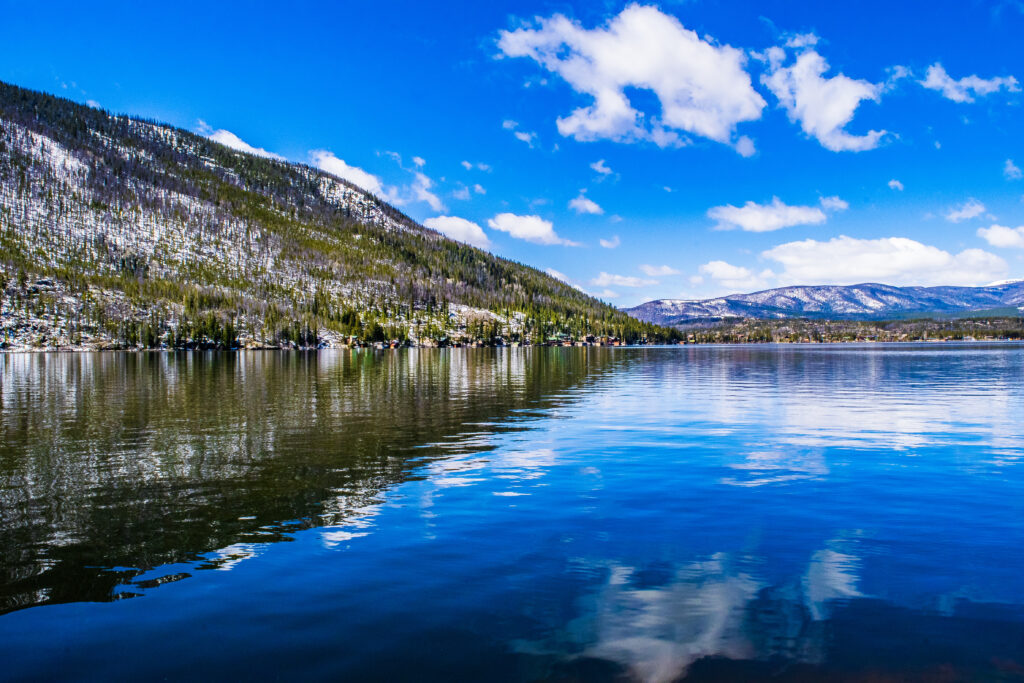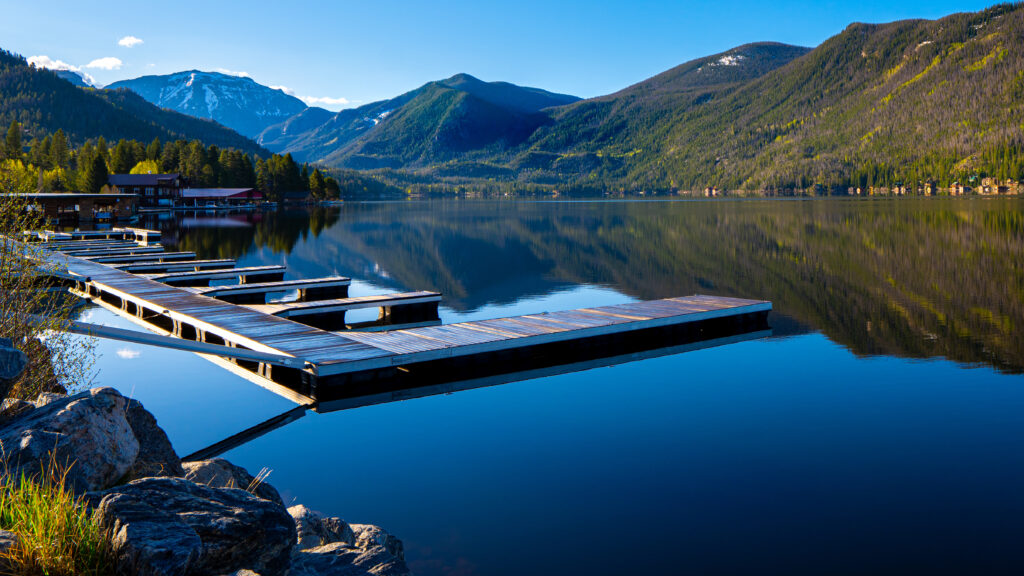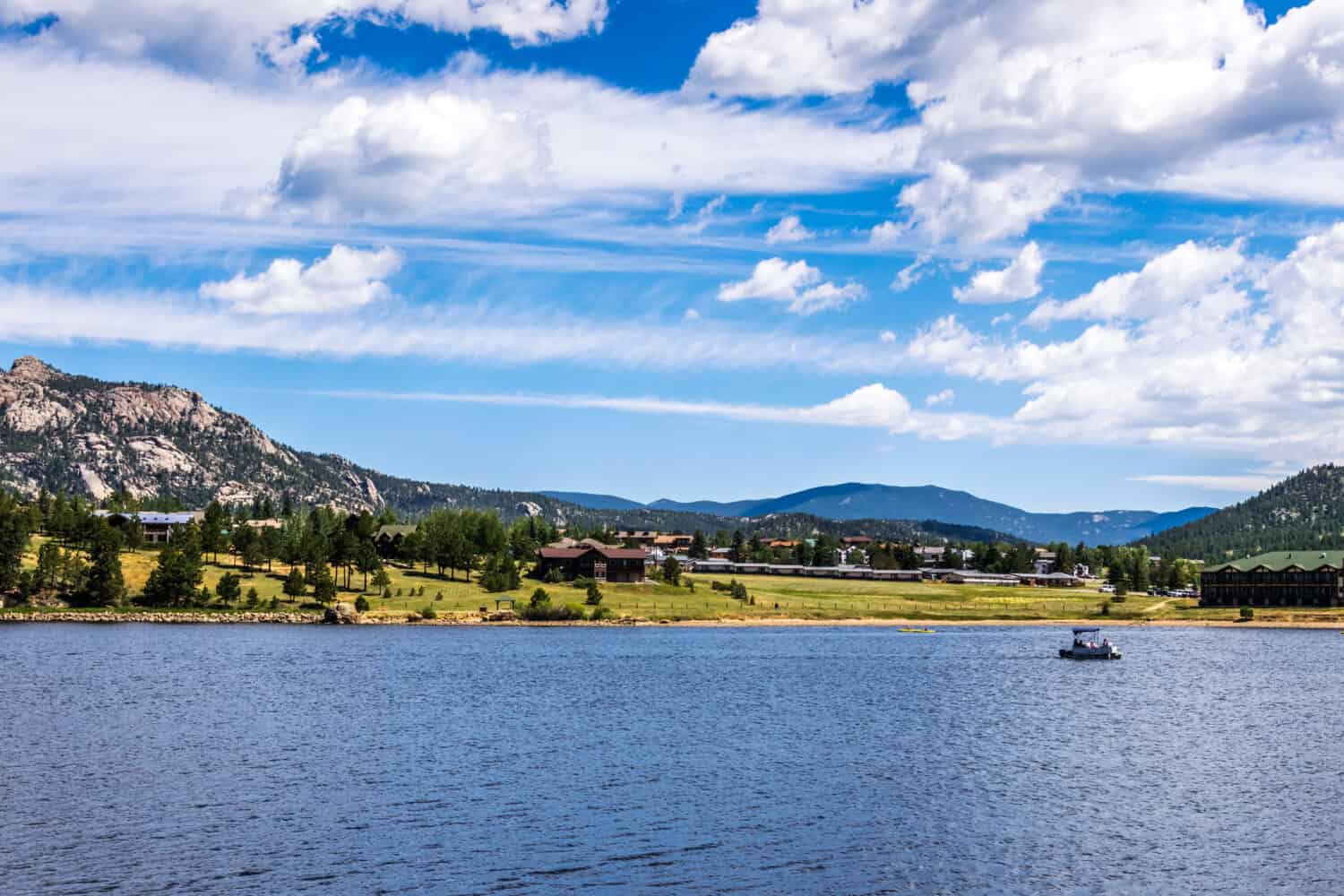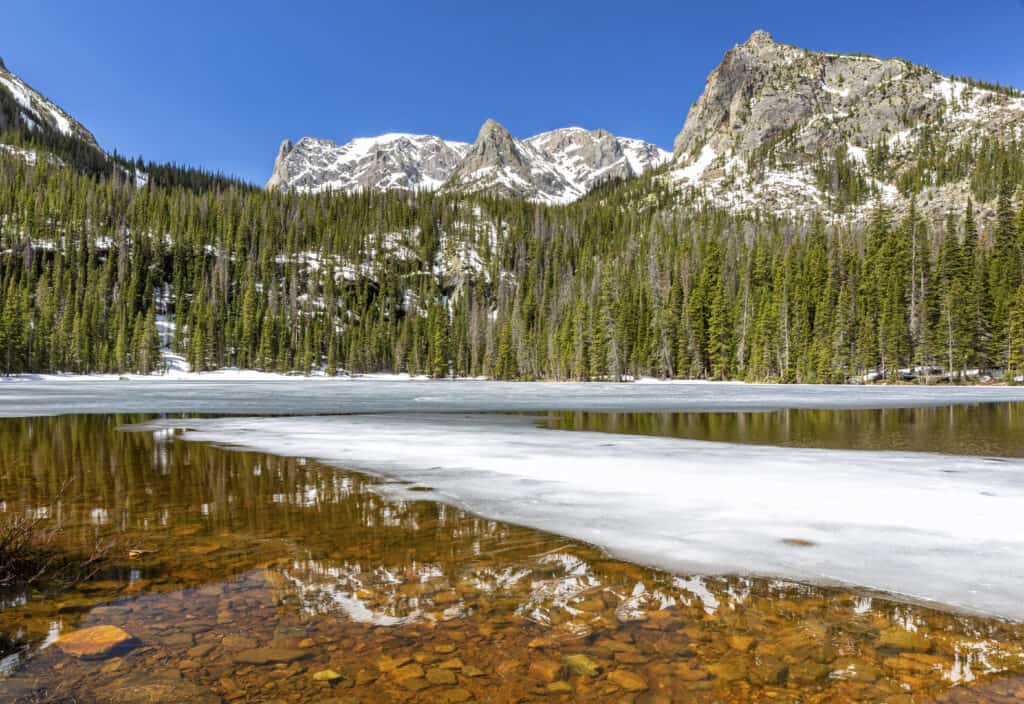
The Rocky Mountains, or the Rockies, are North America’s most extensive mountain system. They cover about 3,000 miles, stretching across eight beautiful states — Colorado, Nevada, Arizona, Idaho, New Mexico, Wyoming, Utah, and Montana.
Did you also know the Rockies are about 35-80 million years old? Their age is only one of the many fascinating facts about them. Ideally, they host numerous attractions, including panoramic parks, historic sites, and over 150 splendid lakes! These magnificent bodies of water boast varying features, including size and depth.
In this article, we’ll dive into the Rocky Mountains’ deepest lake, unveiling its identity, features, and some of the most exciting things to do around it. Let’s get started!

The Rocky Mountains are 35-80 million years old and home to over 150 lakes.
©True Touch Lifestyle/Shutterstock.com
Which is the Deepest Lake in the Rocky Mountains?
With a maximum depth of 389 feet, Colorado’s Grand Lake takes the cake for the deepest lake in the Rocky Mountains. It covers 507 acres of national forest land, making it the largest natural body of water in the Centennial State.
Grand Lake is nestled within Grand County’s Grand Lake – a town it shares a name with – roughly 98 miles from Denver, Colorado’s capital. The Rocky Mountain National Park borders it on three sides, partially explaining why thousands worldwide are drawn to it.
History of Grand Lake
Grand Lake was formed through glacial activity near the headwaters of the 1,450-mile-long Colorado River. The native Ute tribe initially named it “Spirit Lake,” believing its serene waters were home to departed souls.
In the 1880s, European hunters traversing the region stumbled upon this massive lake and were mesmerized by its beauty. Its popularity soared tremendously after that, leading to the birth of the town Grand Lake, which became a base for passionate adventurers, including hunting enthusiasts who craved easier access to the water body.
In the 1940s, the Colorado-Big Thompson Project (C-BT) saw the diversion of Grand Lake to the east through the Alva B. Adams Tunnel. The water was – and still is – handy for several undertakings, including irrigation, hydroelectric power generation, and municipal and industrial purposes.

Colorado’s Grand Lake is the deepest lake in the Rocky Mountains with a maximum depth of 389 feet.
©Jeremy Janus/Shutterstock.com
The Climate in Grand Lake
Grand Lake’s climate is usually mild throughout the year. Summers are sunny and warm, with the temperatures in July hitting 76 degrees. Combined with June, these are the region’s most pleasant months.
On the other hand, winters around Grand Lake are uncomfortable because the temperatures drop to around 6 degrees, lower than most regions in Colorado. Consequently, December and January are the area’s coldest months.
Grand Lake also has a history of having extremely low humidity at various times of the year, causing some of its guests’ skin to become itchy.
Wettest, Driest, and Snowiest Months in Grand Lake
Grand Lake’s wettest and rainiest month is August when the area receives up to 2.0 inches and about 14.1 days of rain. On the contrary, the region’s driest month is February, with only 1.2 inches of rain.
December is Grand Lakes’ snowiest month, with up to 20.9 inches of snow. Also, the area’s annual snowfall is 128.6 inches, meaning it’s snowier than many other parts of Centennial State.
Five Thrilling Things to Do in Grand Lake
A trip to the Rocky Mountains’ Grand Lake allows you to:
1. Enjoy Fishing
Grand Lake ranks among the best fishing holes in Colorado, being home to these fish species:
- Lake trout
- Kokanee salmon
- Cutthroat trout
- Brook trout
- Rainbow trout
Thankfully, Colorado Parks and Wildlife regularly stocks Grand Lake, so your chances of going home empty-handed are slim. While angling on a boat is thrilling, you can still cast from the shore, owing to the multiple docks designed for anglers. The body of water freezes in the winter, making it the ideal destination for enthusiastic ice fishers.

While angling on a boat is thrilling, you can still cast from the shore on Grand Lake, owing to the multiple docks designed for anglers.
©Markel Echaburu Bilbao/Shutterstock.com
Grand Lake Fishing Regulations
If you’re above 16, you must have a valid Colorado fishing license to fish in Grand Lake. You can easily acquire one near the water body’s entrance on Highway 34 at the Conoco gas station. Since the lake is open all year round, you can plan your angling trip any time.
However, it’s wise to familiarize yourself with all the rules governing fishing in Grand Lake before you start angling. For example, all lake trout measuring 26-36 inches are only for catch and release. If you’re lucky enough to land one over 36 inches, you can take it home but don’t exceed four live specimens.
Also, while leveraging various fishing strategies at Grand Lake, refrain from using gaffs and tail snares as it’s illegal.
2. Take a Dip
Grand Lake is a haven for swimmers hoping to cool off, especially during the hot summers. The sandy, family-friendly beach lets you relish the activity with your little ones. However, the area lacks lifeguards, meaning you must watch over them closely for safety.
It’s worth noting that swimming in Grand Lake is nothing close to your home or community pool. Again, remember this is Colorado’s deepest lake, so the last thing you need is to swim in its deeper regions with little experience. We recommend having a proficient swimming buddy with you and don’t forget to bring the necessary safety gear, including:
- Life jackets
- Ear plugs
- Nose clips
- Arm floaties
- Rings
- Goggles
- First aid kit
On top of that, swimming within your comfort zone is advisable while at Grand Lake — your goal should be to have a good time in the water, not compete with other swimmers.
3. Delight in a Cruising Adventure
If you fancy sailing, Grand Lake deserves your attention as it’s one of the treasured boating destinations in the Rocky Mountains. Certainly, it’s a refreshing way to spend quality time alone or make memories with friends while enjoying picturesque mountain views. Even more convenient, both motorized and non-motorized boats are allowed here.
On top of that, boat rentals are available on-site. Consider the Grand Lake Marina, which has been in business since 1972. They offer many options, from canoes and kayaks to pontoon boats and paddleboards. Moreover, they operate the only coffee shop with lakeside seating in the region so that you can stop by for their chai latte or cappuccino after your sailing trip.

Grand Lake is a prime destination for boating enthusiasts
©Greens and Blues/Shutterstock.com
4. Explore Rocky Mountain National Park
You can’t miss Rocky Mountain National Park during your visit to Grand Lake. It sits between Estes Park and Grand Lake, meaning is easily accessible from the latter. Rocky Mountain National Park is heaven for mountain bikers and hikers since it offers countless trails and dirt roads to discover.
- Mammals – Bighorn sheep, black bears, beavers, coyotes, yellow-bellied marmots, mule deer, mountain lions, snowshoe hare, pikas, and bats.
- Birds – Western tanagers, raptors, white-tailed ptarmigan, gray jay, red crossbill, mountain chickadee, dusky grouse, pine grosbeak, hawks, falcons, ospreys, American dippers, Clark’s nutcracker, vultures, eagles and kestrels.
- Reptiles and Amphibians – Prairie lizard, western toad, boreal chorus frog, western terrestrial garter snake, and barred tiger salamander.
- Arthropods – Dragonflies, bees, Eleodes, monarch caterpillars, crab spiders, butterflies, and tent caterpillars.
This national park is also home to some threatened species in Colorado, including Canada lynx, Greenback cutthroat trout, North American wolverine, and Mexican spotted owl. Others, like the Arapahoe snow fly, are candidates for listing due to their rapidly declining populations.
You can also observe the numerous plant species around. As any botanist or plant enthusiast can attest, the Rocky Mountain National Park’s flora is captivating. Nearly every inch of this region is covered with various plant species, including shrubs like willow, kinnikinnick, shrubby cinquefoil, common juniper, wax currant, wild rose, and rocky mountain maple.
Wildflower lovers will be awed by the hundreds of species inhabiting the national park. Some of the most common ones are spotted coralroot, fairly slipper, shooting star, dwarf clover, king’s crown, queen’s crown, common fireweed, moss campion, parry primrose, and mountain ball cactus.
As you tour this 265,769-acre national park, other plants you’ll likely see are lichens, algae, mosses, and liverworts. Moreover, the region hosts invasive exotic species like cheatgrass, Canada thistle, and woody mullein.
5. Hone Your Photography Skills
Anyone into nature photography will have the time of their life at the Rocky Mountain National Park. There’s an extensive list of things to photograph, ranging from the gorgeous landscapes and sunset views to the many plant and animal species dominating the region. Some professional photographers, such as Eric Stensland, owe their flourishing careers to this scenic destination.
If you’re a photographer exploring Rocky Mountain National Park, timing and location are everything. Spots like Bear Lake, Rock Cut, Gore Range Overlook, and Forest Canyon Overlook suit those hoping to capture spectacular sunset shots. Some amazing sunrise locations include Moraine Park, Dream Lake, and Sprague Lake.
Moreover, you don’t necessarily have to be a pro photographer with a top-of-the-line camera to enjoy photography here. You can still take incredible photographs with your smartphone and post them on your blog or Instagram.
Prettiest Nearby Lakes
As mentioned earlier, the Rocky Mountains are home to over 150 lakes, most of which are near Grand Lake. Of course, visiting all of them can be a tall order, especially if you’re in the region for only a few days. How about swinging by the most scenic ones? Check out our top recommendations.
Emerald Lake
Any reveler who’s been to Emerald Lake will agree that it’s stunning, with its deep green water and incredible alpine views. It’s most popular among hikers, who explore its many trails lined with ponderosa pine and aspen grooves. Because this body of water welcomes many nature enthusiasts daily, we suggest coming here early to reserve your spot.
Unfortunately, pets are prohibited around Emerald Lake, meaning you must leave your furry buddy at home. Nonetheless, the national park won’t charge extra fees to explore this breathtaking water body.
Dream Lake
Emerald Lake and this exquisite lake are only ten minutes apart. Like the former, Dream Lake is a premium spot for casual hikers who enjoy pristine views of the surrounding cliffs. Swimming is also popular here, but its waters are chilly since an alpine glacier feeds it.
Like its neighbor, Emerald Lake welcomes visitors throughout the year. However, pets and backcountry camping are prohibited. On the upside, this is a family-friendly spot ideal for vacations with your loved ones.
Sprague Lake
Touring the picturesque Sprague Lake should be on your bucket list if you visit Grand Lake. Unlike Emerald Lake and Dream Lake, this body of water welcomes as many anglers as hikers, most interested in brook trout fishing. Still, several easy trails attract beginner hiking enthusiasts within the Rocky Mountain National Park.
Visitors can’t swim in Sprague Lake to protect the fish species inhabiting it. This body of water also sits on Bear Lake Road, so you’ll need a timed permit to access it. If you’re coming from Estes Park, use Highway 36 West to enter the Rocky Mountain National Park at the Beaver Meadows Entrance Station. From there, you’ll find signs directing you to the lake.

Sprague Lake is where the fish tales never end.
©Greens and Blues/Shutterstock.com
Fern Lake
Mainly fed by the Big Thomson River, Fern Lake is also on the list of the Rocky Mountains’ most beautiful bodies of water, though it’s not as flashy as options like Emerald Lake. Many hikers exploring it are fond of its serene environment that allows them to soak in nature’s beauty, relish some me time, or connect with loved ones.
Fern Lake also offers incredible waterfall views, especially in June when the snow melts. Nevertheless, the area surrounding the lake is home to nagging swarms of mosquitos, so you should bring bug spray on your trip. If you have plenty of free time, visit the nearby Lake Helene, Spruce Lake, and Odessa Lake.

Fern Lake is a beautiful alpine lake in Colorado.
©iStock.com/lightphoto
Timber Lake
Situated on the Rocky Mountain National Park’s western edge, Timber Lake is another breathtaking body of water near Grand Lake. It has well-defined trails for hiking lovers who delight in elk, moose, and bear sightings.
The Timber Lake trail is a great place for wildflower enthusiasts as it has a variety of them, ranging from white bog orchids and elephant heads to pink wintergreen and Rocky Mountain fringed gentian.
In addition, this stunning lake’s eastern side is lined with rugged cliffs of gray metamorphic rock, while trees occupy the western edge.
Savor Every Moment You Spend at the Rocky Mountain’s Deepest Lake
With so many stimulating things to do at Grand Lake, discovering it should be on your list of must-do activities in Colorado. You can use the Estes Park Shuttle or self-drive if you’re coming from Denver.
Nevertheless, we recommend thorough planning before journeying into the deepest lake in the Rocky Mountains.
One of the critical steps to take in advance is to book accommodation within the nearby region. If you’re hunting for comfort and convenience, consider the Western Riviera’s Lakeside Lodging, only a minute from the body of water. Other top-rated options include Grand Lake Lodge, Grand View Mountain Lodge & Restaurant, and Gateway Inn.
Where is Colorado’s Grand Lake Located on a Map?
Grand Lake, a statutory town in Grand County, Colorado, United States, is home to a population of 410 residents, as recorded in the 2020 United States Census.
Here is Colorado’s Grand Lake on a map:
The photo featured at the top of this post is © Markel Echaburu Bilbao/Shutterstock.com
Thank you for reading! Have some feedback for us? Contact the AZ Animals editorial team.







